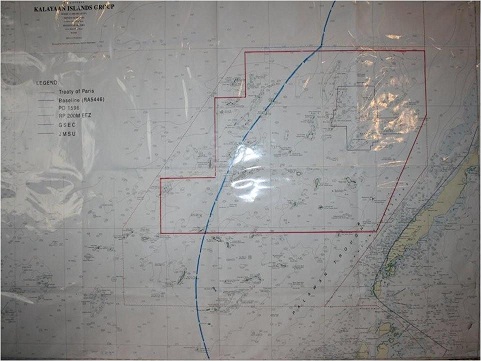
The red line is the coverage of the JMSU. The area to the right of the blue line is Philippine-claimed territory.
Retired Philippine diplomat Alberto Encomienda quipped when he delivered his paper “The South China Sea: Back to the Future through Cooperation” that with all meetings and conferences, as many as 20 in one year, being held on the South China Sea, it’s no longer “confidence building.”
We are now experiencing “conference building,” he said.
But as Winston Churchill wisely said, “To jaw-jaw always is better than to war-war.”
The organizers of last week’s Manila Conference on the South China Sea deserve congratulations for a substantial program. They got excellent speakers. Even if many of the papers presented overlapped with each other, which cannot be avoided because they revolved around one subject, they all helped in the deepening of understanding of the issue that keeps on popping up on an otherwise stable region.
The attendance of a Southeast Asia expert from China (Xiamen University) balanced the attendance in the conference which was organized by the Foreign Service Institute of the Philippine Department of Foreign Affairs, the National Defense College of the Philippines and the Development Academy of Vietnam.
Prof. Shen Hong-Fang, senior research fellow of the Center of Southeast Asian Studies of Xiamen University, did not mince words in delivering what many China experts among the participants considered the message from the Chinese government.
Shen said China is firm in its stand about its historical right to the area as shown in its nine-dash line map which covers almost the whole of South China Sea. She said China would still prefer talks with other claimant countries on the bilateral level. This is contrary to the direction being taken by the Association of Southeast Asian Nations, of which four other Spratly claimants are members — Brunei, Malaysia, Philippines, Vietnam — of dealing with China as a group.
Shen startled participants when she said hardliners in the Chinese Military Academy, a think-tank of the People’s Liberation Army, are suggesting that it’s about time to “teach some countries a lesson.”
A more sober view of China was presented by Li Mingjiang of the S. Rajaratman School of International Studies in Singapore.
Li said: “China is likely to practice self-restraint so as to avoid a major confrontation with Southeast Asian countries. Beijing is also likely to reciprocate any regional states’ goodwill to prevent any crisis from escalating into a confrontation.”
He said even as China would avoid confrontation, it will “be more assertive in handling regional disputes in the coming years.”
Li said: “In response to China’s non-confrontational assertiveness, Asean (or some Asean countries) may attempt to play the balance of power game by getting external powers, i.e. the US involved in the dispute. This strategy might be effective to some extent in taming China’s assertiveness. Overly playing this game may result in China hardening its position and adopting counter-measures, which may further complicate the South China Sea dispute and damage the bilateral relations between individual Asean countries and China as well.
Asean, Li further said, “can play a pro-active role in helping shape China’s strategic thinking. It could constantly try to convince China that properly managing the dispute serves China’s strategic and long-term interests.”
Li said Asean could continue to socialize China in various regional institutions and forums.” And most importantly, he said, “Asean (especially those claimant countries) could perhaps seriously consider the ‘joint development’ option as there is still fairly strong political and intellectual support for such initiative in China.”
The problem with joint development is capsulized by Dr. Tran Truong Thuy of the Diplomatic Academy of Vietnam, who said in determining the coverage, some countries practice: “What is mine is mine and what is yours, we share.”
That was what happened in the Joint Marine Scientific Undertaking, a brainchild of former House Speaker Jose de Venecia, entered into by the Arroyo government with China and later on Vietnam in which 70 percent of the coverage of the project was in areas being claimed by the Philippines. It even included areas which were undisputedly Philippine territory.
The constitutionality of the three-year agreement, which was completed in 2008, is being questioned before the Supreme Court.
In October, another symposium on South China Sea will be held in Manila. It is being organized by the Carlos P. Romulo Foundation for Peace and Development with the Institute of South East Asian Studies (ISEAS) of Singapore as co-sponsor.
Former Foreign Secretary Roberto Romulo, chair of the CPR Foundation, said, “The hope is that this will help governments conduct more meaningful dialogue.”